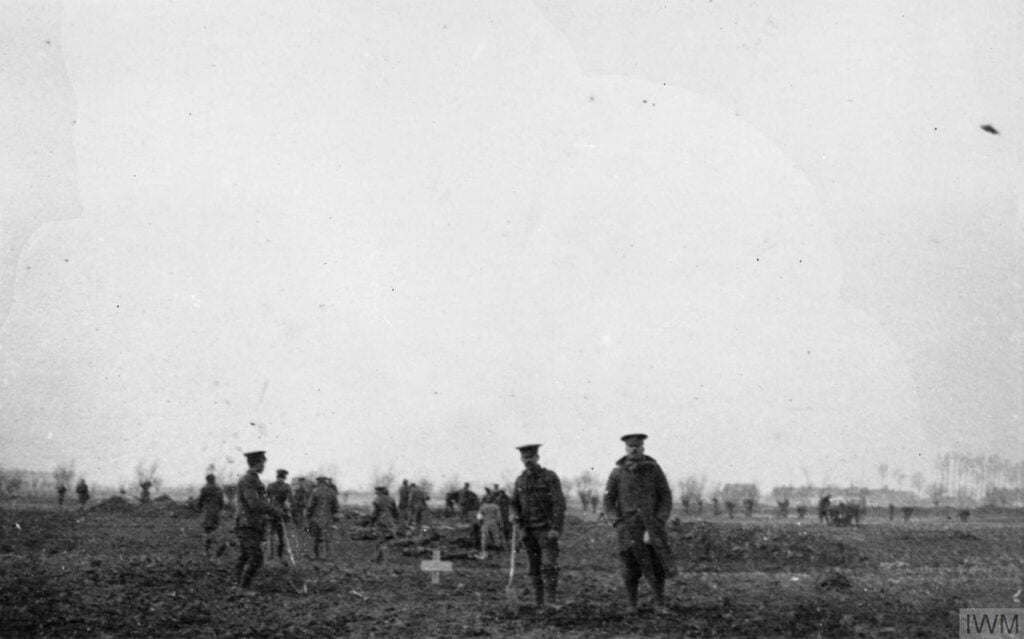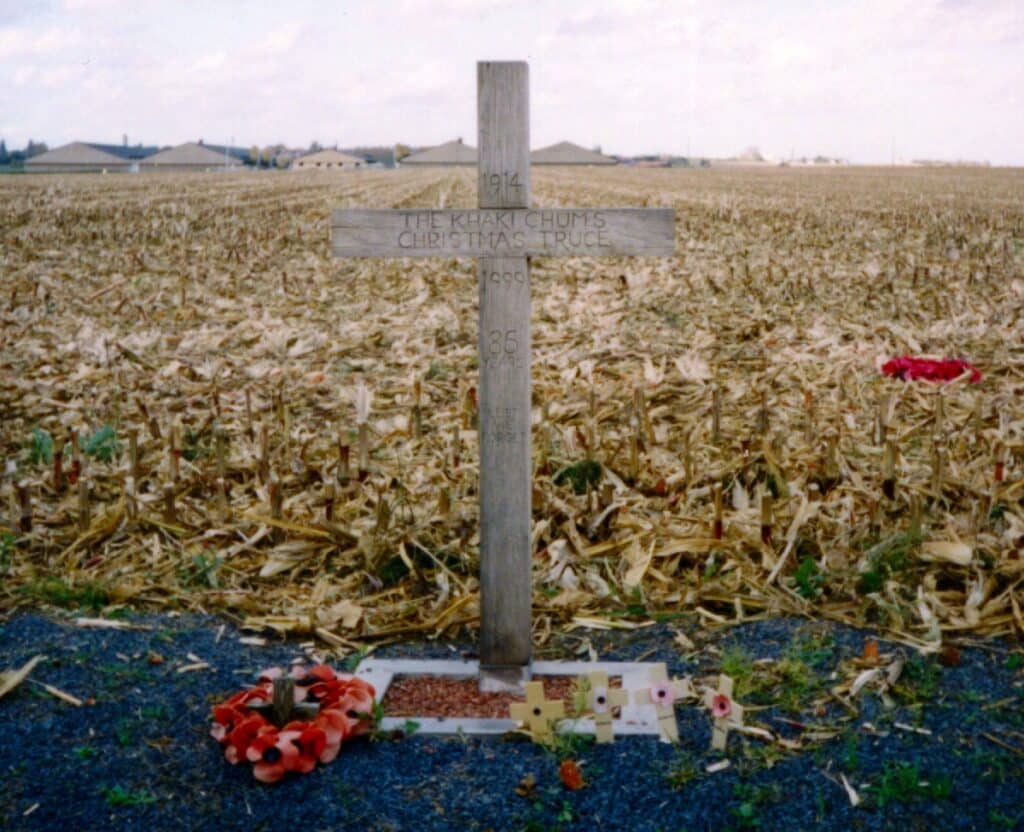Did you know that during World War 1 shots suddenly ceased fire on Christmas Day? Yep! It’s a true story! I thought that was so cool that even during the trawls of war a Christmas miracle could happen. Often called “WWI the Christmas Truce”, here’s what happened.
I need to take you back to 1914, during World War 1. If you’re not current on your history, this was the year the war began. By the time December 1914 rolled around soldiers from the Triple Entente (Britain, France, and Russia) were deep into war with the Triple Alliance (Germany, Italy, and Austria-Hungary.)
The Complete History of the The Christmas Truce From World War 1
WWI started on June 28th, 1914 after Archduke Franz Ferdinand was assassinated. This was, of course, just the catalyst; tensions had been high for quite some time.
The first war strategy that the Germans underwent was the “Race to the Sea”, which was essentially an attack on France with the intention of pushing forward to the Atlantic Ocean. Although the Germans could launch U-Boats (submarines) from the North Sea.
U-Boats were responsible for sinking smaller and merchant ships in 1914 and in 1915 took down two Dreadnought battleships and the RMS Lusitania, a large passenger ship filled with American and British civilians.

The Begging of World War 1: November, 1914
The First Battle of Ypres played out through November, ending in a stalemate on the 20th in 1914. While this first battle resulted in pretty significant losses, it was the second battle of Ypres that’s more famous in history. Also known as Flanders, Ypres was where the Germans first used gas in warfare. That battle also inspired Canadian medical office John McCrae’s famous poem “In Flanders Field“.
That’s later, though. We’re back in 1914 before British, Canadian, and French soldiers had ever heard of chlorine gas. WWI was primarily trench warfare, and these trenches were often situated in close proximity to one another. That meant that enemies and allies were typically within shouting distance.
As the battle came to an end and held their ground, the fighting slowed. Near the beginning of November, for example, food was delivered to the front lines at dusk. Both sides ceased fire allowing the meals to be delivered.

Celebrating the Holidays During War: December, 1914
We see these dates on a timeline and simply remember the facts, but it’s important to consider that these were real people. Many of which hadn’t been in battle or war before. This is true for both sides. A few weeks in a trench probably felt like an eternity to these soldiers.
As mentioned before, the trenches were close enough that you could interact with your enemies at times. By December 1st, the battled had slowed so far that a German Sargent visited the British soldiers to “to see how we [they] were getting on”.
The same soon happened between French and German soldiers (whose relationship was much more tense), eventually leading them to form a 30 minute truce each evening the recover and bury dead soldiers. According to a German surgeon, they also exchanged newspapers with their enemies during this time.
Fraternizing With the Enemies? The Generals Didn’t like It
Of course, this was a war, and those in command wanted enemies to remain that way. This kind of fraternization was discouraged, and on December 7th, 1914 lieutenant Charles de Gaulle called the desire of the French infantrymen to leave in the enemy in peace “lamentable”.
Another commander wrote of the “unfortunate consequences” when men “become familiar with their neighbours opposite”.
These truces were different to the ones that formed naturally, usually from poor weather. Trenches had a tendency to flood, after all.

What Happened During The WWI Christmas Truce in 1914?
Tensions stayed the same during December on the Western Front. On Christmas Eve, Germans started celebrating by placing candles on their trenches and on Christmas trees (Tannenbaum). They also began singing Christmas Carols in German, sometimes even accompanied by the army’s band if there was one.
British soldiers joined in too. Before long they emerged from the trenches and met on No Man’s Land, a neutral area. It’s important to note here that this wasn’t just one area; there were several fronts that all formed a Christmas truce in different areas.
Small gifts such as food, tobacco, alcohol, souvenirs, hats, and buttons were exchanged. Recently killed soldiers could be retrieved, and joint services were held for Christmas and the dead.
Most famously, there were also Christmas Day football [soccer] games. Played in No Man’s Land or in front of the trenches, probably informally with old cans since there was no equipment around.
Similar truces occurred on the Eastern Front, with Russian and Austria-Hungary soldiers exchanging small gifts and well-wishes.
A Quote from Henry Williamson on The Christmas Truce
“Dear Mother, I am writing from the trenches. It is 11 o’clock in the morning. Beside me is a coke fire, opposite me a ‘dug-out’ (wet) with straw in it. The ground is sloppy in the actual trench, but frozen elsewhere. In my mouth is a pipe presented by the Princess Mary. In the pipe is tobacco. Of course, you say. But wait. In the pipe is German tobacco. Haha, you say, from a prisoner or found in a captured trench. Oh dear, no! From a German soldier. Yes a live German soldier from his own trench. Yesterday the British & Germans met & shook hands in the Ground between the trenches, & exchanged souvenirs, & shook hands. Yes, all day Xmas day, & as I write. Marvellous, isn’t it?”
Henry Williamson
This was in a letter he wrote on Boxing Day to his mother. Williamson was a 19 year old British private at the time in the London Rifle Brigade, which was a volunteer regiment.

True Facts About The WWI – The Christmas Truce
About 100,000 Soldiers Participated in the Christmas Truce During WW1
This is just counting the British and German soldiers on the Western Front.
Holiday Festivities Between the British and German Soldiers Lasted as Long as a Week
In some areas it started Christmas Eve and lasted all the next day into Christmas night. Other places had truces that lasted until New Year’s.
There Was Still Fear During Christmas in the Trenches
Some British soldiers, especially officers, did not participate or observe in the festivities out of fear of German snipers seizing the opportunity.
The Black Watch’s Account Confirms the Christmas Truce
A member of the Black Watch was billeted in a farmhouse away from the front line, but observed the Christmas Truce by the silence that came when the firing halted.
The Press Was Censored When Reporting the Events of the WW1 Christmas Truce
There was an unofficial embargo surrounding reporting on the WII Christmas Truce but it was broken a week later on December 31st, 1914 by the New York Times. At this point, the United States was a neutral party in the war. British papers soon followed with first hand accounts of what happened. This was still censored, though.
In France, the press was completely censored and it was not reported on. Eventually they had to respond to first-hand accounts and growing rumours, and eventually admitted that it had occurred but that the truce was merely “little more than an exchange of songs which quickly degenerated into shooting.”
German papers also reported on the events but with much criticism and no pictures.
Another Christmas Truce Didn’t Happen Again
British commanders didn’t like the idea of making friends with the enemy, so future truces and fraternizations were discouraged. The war wouldn’t end until 1918, but it was only Christmas 1914 that had this large scale of a Christmas Truce.
German commanders also disagreed. So did Adolf Hitler who was also serving in the German army at the time.
There is a Christmas Truce Memorial
It’s located in Frelinghien, France.

A Look Back on WWI – The Christmas Truce
So there you have it. As we move into the holidays this year I think it’s important to remember the spirit of Christmas. With so many of us facing losses and lockdowns, we need peace and friendship more than ever.












0 Comments